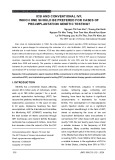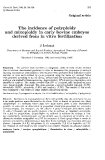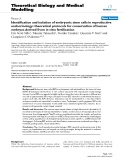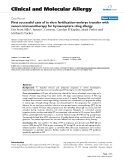
56
Journal of Medicine and Pharmacy, Volume 13, No.04, June-2023
In vitro fertilization outcomes In infertile women with adenomyosis
Tran Ngoc Ha Giang1, Le Minh Tam1*
(1) Hue University of Medicine and Pharmacy, Hue University
Abstract
Objectives: This study aimed to investigate the efficacy of in vitro fertilization (IVF) in infertile patients
with adenomyosis and to identify relevant factors. Subjects and methods: Retrospective descriptive study
of infertile cases with adenomyosis who received IVF therapy and embryo transfer from November 2013 to
October 2022 at the Center for Reproductive Endocrinology and Infertility, Hue University of Medicine and
Pharmacy Hospital, excluding cases of oocyte donation or surrogacy. The β-hCG test was examined two weeks
following embryo transfer. Then, women with hCG positive test were followed the pregnancy at 6 weeks, 8
weeks, and 12 weeks, and examined some factors that influence the clinical outcome of pregnancy. Results:
Among 61 cycles of IVF treatment for infertile patients with adenomyosis, the average number of retrieved
oocytes was 10.9±6.6 oocytes. The percentage of mature oocytes was 82.7%, the fertilization rate was 79.5%,
the implantation rate was 16.7%, the clinical pregnancy rate was 19.7%, the miscarriage rate was 6.6%, and
the ongoing pregnancy rate was 13.1%. In the group with GnRH agonist administration before embryo transfer,
the pregnancy rate was greater than in the group without therapy (29.2% vs. 13.5%), and th e pregnancy rate
in the group with > 10 oocytes was higher than in the group with ≤ 10 oocytes (28.0% vs 13.5%). However,
these differences were not statistically significant (with p > 0.05). The cut-off point of endometrial thickness
on the day of hCG injection, 10.25 mm, had a sensitivity of 58.3%, a specificity of 81.6%, an area under the
curve (AUC) of 75.6%, and a p-value of 0.006; the cut-off point of endometrial thickness on the day of embryo
transfer, 9.75 mm, had an accuracy of 9.75 mm. sensitivity 75%, specificity 71.4%, AUC 78.50%, p = 0.002 for
clinical pregnancy prognosis. Conclusion: The IVF treatment of infertile patients with adenomyosis remains
challenging, and additional research is required to explain the influence of this disorder on IVF outcomes.
Keywords: in vitro fertilization (IVF), adenomyosis, β-hCG.
Corresponding author: Le Minh Tam, email: leminhtam@hueuni.edu.vn
Recieved: 29/1/2023; Accepted: 14/3/2023; Published: 10/6/2023
DOI: 10.34071/jmp.2023.4.8
1. INTRODUCTION
Endometriosis is a benign condition characterized
by the development of endometrial glands and
stroma outside the uterine cavity [1]. This disease
affects 6-10% of women, with symptoms ranging
from no symptoms to severe symptoms, and can be
accompanied by a variety of symptoms, including
dysmenorrhea, dyspareunia, infertility, and urinary
troubles, with the most prevalent symptoms being
dysmenorrhea, pelvic discomfort, and infertility. Up
to 25 - 50% of infertile women have endometriosis,
while 30 - 50% of endometriosis-affected women
are infertile [2]. These findings indicate that
endometriosis is strongly associated with female
infertility.
Adenomyosis is a form of endometriosis
characterized by the development of localized or
diffuse glandular tissue inside the myometrium
[1]. Despite the benign nature of this invasion,
ectopic glandular tissue can result in dysmenorrhea,
hypogastric retention, and abnormal uterine
bleeding. Excessive growth of adenomyosis can
result in uterine deformities, constriction of the
uterine cavity, and decreased fertility by impeding
embryo implantation and increasing the risk of
miscarriage, significantly impacting the quality of
life of women [1-2].
In vitro fertilization (IVF) is one of the best
options for treating infertility and is a fairly common
method for infertility caused by endometriosis. Up
to now, studies on the impact of adenomyosis on IVF
outcomes have not been consistent. Some reports
suggest that IVF reduces the ability of embryo
implantation and pregnancy development, so the
clinical pregnancy rate, the live birth rate after IVF
in these patients is lower than in the control group
[3-4]. Meanwhile, another study reported that IVF
did not affect pregnancy outcomes after IVF [5-6].
Although assisted reproduction techniques
are growing day by day, IVF treatment in infertile
patients with adenomyosis is still a challenge. This
study aimed to evaluate the results of IVF and to find
out some factors affecting the treatment outcomes
in infertile patients with adenomyosis.

























